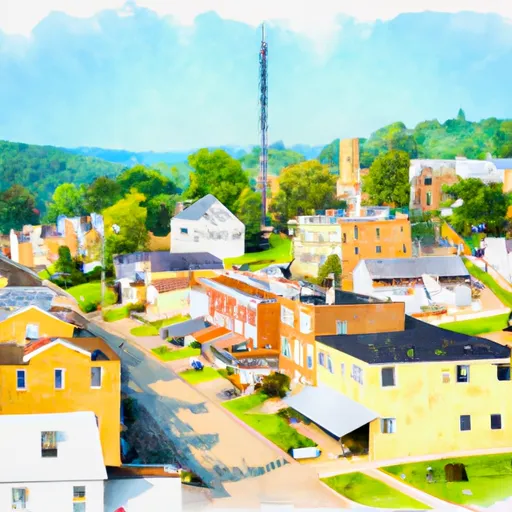-
 Snoflo Premium
Snoflo Premium
Get unlimited access to all our content
With no Ad interruptions! - Start Your Free Trial Login with existing account
Stoystown
Eden Index
Climate
7.2
•
Recreation
5.2
•
Community
0.8
•
Safeguard
4.9/10

Stoystown, Pennsylvania is a small borough located in Somerset County. It experiences a humid continental climate, characterized by four distinct seasons. Summers are warm and humid, with average temperatures ranging from 70°F to 80°F. Winters are cold and snowy, with temperatures often dropping below freezing, averaging around 20°F. Spring and fall bring mild temperatures and colorful foliage.
The area is rich in hydrological constituents, primarily due to the nearby Quemahoning Reservoir. This reservoir not only serves as a water supply but also offers various recreational activities such as boating, fishing, and swimming. The nearby Stonycreek River is also popular for fishing, kayaking, and canoeing.
Outdoor enthusiasts will find plenty of opportunities in Stoystown and its surroundings. The borough is surrounded by picturesque mountains, making it a great destination for hiking, biking, and camping. There are several nearby state parks, including Laurel Hill State Park and Laurel Ridge State Park, offering additional outdoor recreation options such as picnicking, hunting, and wildlife viewing.
In summary, Stoystown, Pennsylvania offers a diverse climate with distinct seasons, abundant hydrological constituents due to the Quemahoning Reservoir and Stonycreek River, and numerous outdoor recreation opportunities including boating, fishing, hiking, and camping.
What is the Eden Index?
The Snoflo Eden Index serves as a comprehensive rating system for regions, evaluating their desirability through a holistic assessment of climate health, outdoor recreation opportunities, and natural disaster risk, acknowledging the profound impact of these factors on livability and well-being.
Climate Health Indicator (CHI): 7.2
Stoystown receives approximately
1074mm of rain per year,
with humidity levels near 83%
and air temperatures averaging around
8°C.
Stoystown has a plant hardyness factor of
6, meaning
plants and agriculture in this region thrive during a short period during spring and early summer. Most
plants will die off during the colder winter months.
By considering the ideal temperature range, reliable water supplies, clean air, and stable seasonal rain or snowpacks, the Climate Health Indicator (CHI) underscores the significance of a healthy climate as the foundation for quality living.
A healthy climate is paramount for ensuring a high quality of life and livability in a region, fostering both physical well-being and environmental harmony. This can be characterized by ideal temperatures, reliable access to water supplies, clean air, and consistent seasonal rain or snowpacks.
Weather Forecast
Streamflow Conditions
Allegheny
Area Rivers
Allegheny
Snowpack Depths
Allegheny
Reservoir Storage Capacity
Allegheny
Groundwater Levels
Recreational Opportunity Index (ROI): 5.2
The Recreational Opportunity Index (ROI) recognizes the value of outdoor recreational options, such as parks, hiking trails, camping sites, and fishing spots, while acknowledging that climate plays a pivotal role in ensuring the comfort and consistency of these experiences.
Access to outdoor recreational opportunities, encompassing activities such as parks, hiking, camping, and fishing, is crucial for overall well-being, and the climate plays a pivotal role in enabling and enhancing these experiences, ensuring that individuals can engage in nature-based activities comfortably and consistently.
Camping Areas
| Campground | Campsites | Reservations | Toilets | Showers | Elevation |
|---|---|---|---|---|---|
| Quemahoning Family Rec Area | 63 | 1,668 ft | |||
| New Germany State Park | 48 | 2,565 ft | |||
| Adams Croyle | None | 1,688 ft | |||
| Big Run State Park | 29 | 1,492 ft | |||
| Robert W. Craig - Jennings Randolph Lake | 82 | 1,916 ft | |||
| Savage River State Forest Dispersed | 52 | 2,403 ft | |||
| Lorain Borough Park | None | 1,316 ft | |||
| Nanty Glo Municipal Park | None | 1,733 ft | |||
| Duman Lake County Park | 6 | 1,743 ft |
Nearby Ski Areas
Catastrophe Safeguard Index (CSI):
The Catastrophe Safeguard Index (CSI) recognizes that natural disaster risk, encompassing floods, fires, hurricanes, and tornadoes, can drastically affect safety and the overall appeal of an area.
The level of natural disaster risk in a region significantly affects safety and the overall livability, with climate change amplifying these risks by potentially increasing the frequency and intensity of events like floods, fires, hurricanes, and tornadoes, thereby posing substantial challenges to community resilience and well-being.
Community Resilience Indicator (CRI): 0.8
The Community Resilience Indicator (CRI) recognizes that education, healthcare, and socioeconomics are crucial to the well-being of a region. The CRI acknowledges the profound impact of these elements on residents' overall quality of life. By evaluating educational resources, healthcare accessibility, and economic inclusivity, the index captures the essential aspects that contribute to a thriving community, fostering resident satisfaction, equity, and social cohesion.

